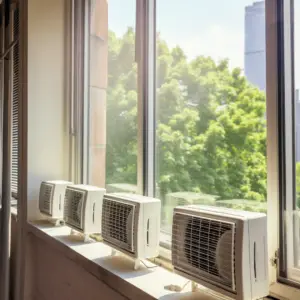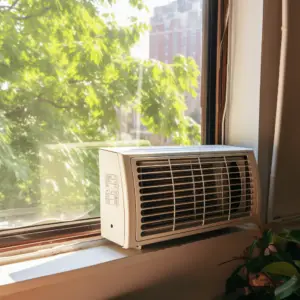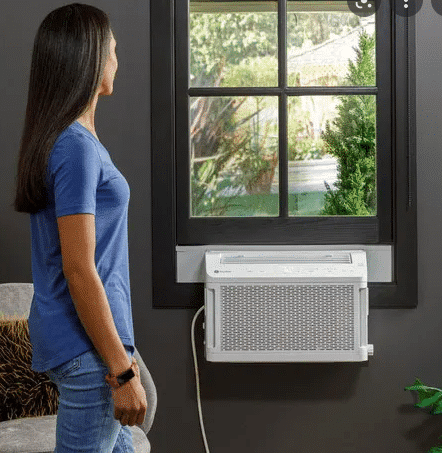Window AC Care is popularly known for removing the heat from the room’s air and replacing it with filtered, cool air without requiring ductwork. It leverages the power of a blower and fans to dispense the warm air and push the cool air into the room.
Does window AC use Freon? The unit uses Freon to formulate cool air and is channeled via a sealed tube. Freon is not supposed to deplete; if it does, it is supposed to be recharged by adding more Freon.
To answer this boggling question comprehensively, read this article to the end.
Table of Contents
Does Window AC Need Freon? What is Freon?

Window AC Care refers to a chemical refrigerant used in air conditioners to cool the air. Freon flows through the ACs where it suctions heat from inside the house and dispenses it outside, cooling your home air.
The only reason your AC’s Freon levels can be low is if there is a system leakage that calls for a professional to fix it.
How Can You Detect Your Window AC’s Low On Freon?
As already mentioned, the only reason for low Freon is leakage. Therefore, it is crucial to watch out for these signs as they indicate low refrigerant.
- No cooling of the house despite the AC running constantly
- There is ice on the refrigerant lines
- The air coming out of your vents is warm
- Hissing or Bubbling sounds from the unit when off.
Whenever you notice some of these signs from your unit, contact your company right away to prevent more loss of the chemical refrigerant and restore the normal functioning of your AC.
In such a case, the AC is “recharged”- adding Freon to the AC unit after a leakage. The homeowners are discouraged from recharging the units themselves. In
How to Add Freon to Your Window AC?
The purpose of the window air conditioning units is to cool offices, RVs, homes, and apartments. Freon is the chemical refrigerant responsible for cooling air. However, recharging is necessary as the unit ages or develops some leaks. Below is a step-by-step guideline on how it is done.
Step 1
Check the air temperature that is released from the unit. Hold a thermometer to the team while operating if its temperature is not cold as it should be. Give it a few minutes to adjust, then record the temperatures down.
Again, check the air temperature being pushed into the unit. Project the thermometer forward for a while, then record the reading temperature.
Step 2
Calculate the difference between the two temperature figures, and if the difference exceeds 20 degrees, then the AC most likely requires cleaning, and if it is lower than 15 degrees, it might need Freon.
Step 3
Remove your AC from the window for necessary repairs. Unscrew the unit panel using a screwdriver and find the two lines connecting to the compressor.
Step 4
The more extensive line among the two is the tube you will use to add the Freon. Connect a tap valve to the tube by adhering to the valve guidelines given.
Step 5
Examine the gauges to ensure they’re turned off. Next, connect the blue tube to the valve you just connected and the compound gauge.
Step 6
Turn your unit to “higher” for a short while, and then attach the yellow tube to the bottle with Freon. Open the Freon valve, loosen the gauge for just a second and then tighten it again. The reason for doing this is to remove air from the tube.
Step 7
Window AC Care initiate the Freon flow, open the valves, monitor the gauges, and let the unit charge up to 70 psi. Switch off the meters and the refrigerant before removing the tubes from the compressor tube where you inserted the valve. Nevertheless, don’t forget to close the new valve.
What Type Of Freon Does Window AC Use?
There are various types of Freon in the market. Therefore, it is essential to use the right kind of Freon. Check the specification sheet or the unit label to identify the refrigerant required to recharge your window AC. For instance, R22 Freon for R22 window AC unit.
How Often Should I Recharge My Window AC?
You don’t need to recharge your AC after a particular time frame. Your air conditioner may function for years without recharging. The only exception to the rule is if the unit isn’t working as before.
And that indicates the underlying issue of a system leak or the device requiring cleaning. For recharging the unit, call an experienced technician to handle it.
5 Steps To Elongate Your Window’s Ac Lifespan
Cleaning the AC is significant as it has many advantages, such as:
- Produce clean air for your room
- Prevent the formation of mold and mildew
- Lowers your energy bills
- Prolongs the unit’s longevity
- Cuts down on repairs
Because lack of proper cleaning of the device might lead to the production of warm air instead of cold, use these five steps as a lifesaver for your window AC
Supplies
- Drip tray
- Warm water
- Rag cloth
- Spray bottle filled with 3% hydrogen peroxide
- Fin comb/Soft bristle brush
- Detergent or mild soap
Clean the Filter
This part of the AC should be cleaned monthly, even if you forgo the rest of the unit. Start unplugging your air conditioner, then remove the filter and front panel.
If the filter is filled with dust and hair, you must vacuum clean it to remove the debris before washing the filter with warm and soapy water and placing it to dry.
After completely drying, you can install it back. If you need a replacement, you can do so depending on the factors, like how regularly you use it. But most recommend it is six weeks- 6 months.
Wipe the Grill and the Exterior

Use a damp cloth to wipe down your grill, or wash it with warm water and mild detergent. Wipe the top and sides of the AC. Don’t run the unit until these parts fully dry.
Dust Off the Fins and the Coils
This component doesn’t require regular cleaning; you can do it after 3 or 6 months.
Gently comb the aluminum fins in your unit using a fin comb or a soft-bristle brush.
Next, dust the coils by spraying the condensed air inside the unit.
Clean Out the Tray and Drain
Wind up your cleaning by emptying the tray and cleaning the tray. You can use a vacuum or a damp cloth to remove everything collected inside, then let it completely dry before you reassemble the unit.
Reassemble and Spray Cleaner
Reassemble your unit and spray it with hydrogen peroxide in spots where the air blows in and out. Allow it to dry for a while before using the air conditioner.
Overall, we can say that window AC uses Freon to cool the air in your home, office, apartment, etc. But the device doesn’t need a recharge of the chemical refrigerant unless there is a leakage in the system’s unit.
If the need arises for an additional Freon, it is wise to use a skilled professional to handle the Freon as it can be hazardous. And if you will do it yourself, then be keen to follow all the instructions per the guidelines.


